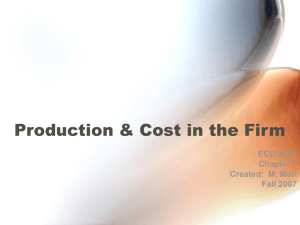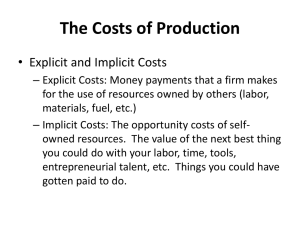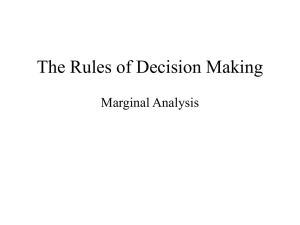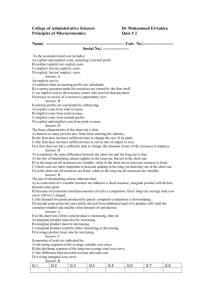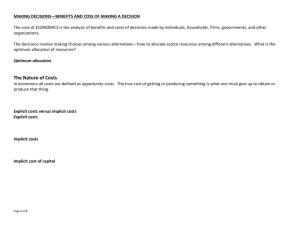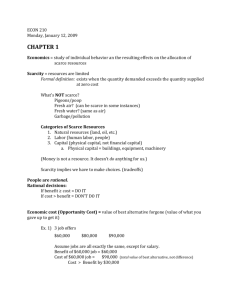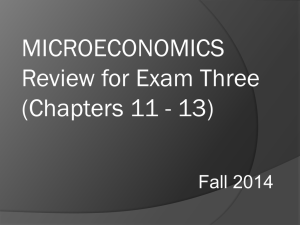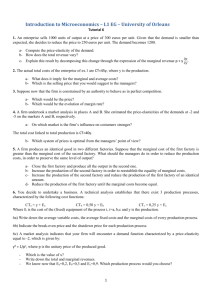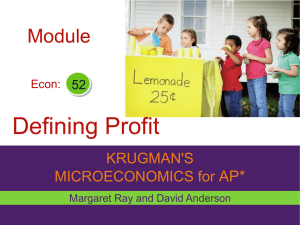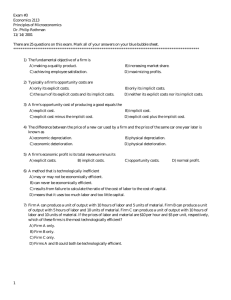Theory of Production and cost
advertisement
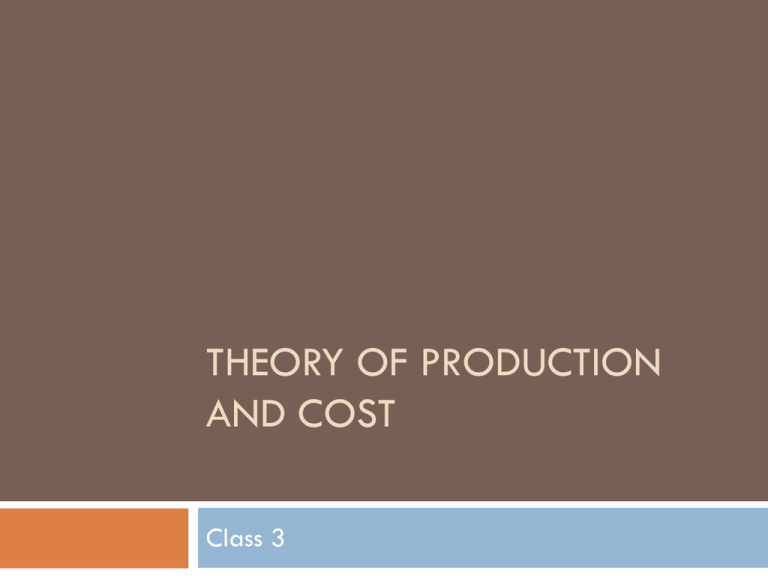
THEORY OF PRODUCTION AND COST Class 3 Theory of Production and Cost Short and Long run production functions Behavior of Costs Law of Diminishing Returns Law of Returns to scale in the theory of production Fixed Costs and Variable Costs Explicit Costs and Implicit Costs What are Costs? “The Market Value of the inputs a firm uses in production” Total Revenue – the amount a firm receives for the sale of its outputs. Eg: Each Ice-Cream takes Rs. 10 to make and it is sold at Rs. 25 – Nelum sells 2000 ice-creams Economic Cost This is different to accounting cost What is account cost? Remember Nelum? – She made Rs. 30000 profit making ice-cream. Assume Nelum was an amazing programmer and she could earn Rs. 80000 a month programming. Her Opportunity cost = 80000 – 30000 = Rs. 50000 Which means she is losing Rs 50000 by making icecream. Implicit and Explicit Costs Explicit Costs – input costs that require an outlay of money by the firm. Implicit costs – input costs that do not require an outlay of money by the firm. Accounting Profit = TR – Explicit Costs Economic Profit = TR – (Implicit Costs+ Explicit Costs) 35 30 25 10 20 20 Profit 15 10 30 10 5 10 10 0 Economic Profit Total Revenue Accounting Profit Implicit Cost Explicit Cost The production functions Output per Marginal Cost of Hour 0 1 2 3 4 5 6 Two Assumptions product of labour factory (FC) Short Cost of workers (VC) Number of Workers Run 0 0 30 0 Size of Nelum’s factory is fixed 50 only vary 50 the amount 30 of ice-cream 10 She can by increasing workers 90 40 30 20 Long run – She can build a new factory. 120 30 30 30 Total Cost 30 40 50 60 140 20 30 40 70 The production function 150 10 80 to The relationship between the 30 quantity of50inputs used make a 155 good and 5he quantity30of outputs for that good. 60 90 Production Function 180 160 140 120 100 Output per Hour 80 60 40 20 0 0 2 4 6 8 Total Cost Total Cost Curve 100 90 Marginal Product 80 The increase in output that arises from an additional 70 unit of output 60 50 Diminishing Marginal Product Total Cost The property whereby the marginal product of an input 40 declines as the quantity of the input increases. 30 20 10 0 0 50 100 150 200 Fixed and Variable Costs Fixed Costs Variable Costs Costs that do not vary with the quantity of output produced Costs that vary with the quantity of output produced. Average Total Cost – Total cost divided by the quantity of output Average Fixed Cost – Fixed cost divided by the quantity of output Average Variable Cost – Variable cost divided by the quantity of output Marginal Cost – The increase in total cost that arises from an extra unit of production. Cups Per Hour Total Cost Fixed Cost 0 300 300 0 0 0 0 1 330 300 30 300 30 330 2 380 300 80 150 40 190 3 450 300 150 100 50 150 4 540 300 240 75 60 135 5 650 300 350 60 70 130 6 780 300 480 50 80 130 7 930 300 630 43 90 133 8 1100 300 800 38 100 138 9 1290 300 990 33 110 143 10 1500 300 1200 30 120 150 Variable Average Fixed Average Variable Average Total Marginal Cost Cost Cost Cost Cost 350 300 250 200 150 100 50 0 0 1 2 3 4 Average Fixed Cost Average Total Cost 5 6 7 8 9 10 Average Variable Cost Observations Rising Marginal Cost Chatura’s MC rises with the quantity of out produced. This reflects the property of diminishing marginal product. U-Shaped Average Total Cost Average fixed costs always reduces Average variable costs typically rises as output increases because of diminishing marginal product The bottom of the U shaped curve occurs at the quantity that minimizes average total cost Long run costs curves In the short term you cannot increase the number of factories, only the number of workers In the long run this is not an issue. Economies of Scale – (Specialization) – When long run average total costs falls as the quantity of output increases Diseconomies of Scale – (Coordination Issue) – When LRATC increase as the output increases Constant returns of scale – When LRATC stays the same as the quantity of output changes. Break Time!

